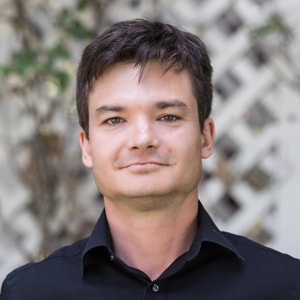Written by Regina Ender
In his new role as a faculty member at APU, Dr. Sándor Volkán-Kacsó is living his dream of becoming both a teacher and a researcher. Surrounded by a community of like-minded faculty members, Dr. Volkán-Kacsó is able to effectively guide his students in physics and their faith. While Dr. Volkán-Kacsó has extensive experience in higher education and research settings, this is his first job as a faculty member at a university since finishing his doctoral program.
He earned both his Bachelor and Master of Science in Physics from Babes-Bolyai University in Romania before serving as an adjunct faculty member in the Department of Electrical Engineering at Sapientia Technical University in Romania. He then went on to attain his Ph.D. from University of Notre Dame. During the time he was working toward his doctorate, he also served as a graduate teaching assistant and graduate research assistant in the university’s Department of Physics and as a graduate fellow in the Department of Mathematics. After completing his Ph.D., Dr. Volkán-Kacsó was a postdoctoral scholar for six years at California Institute of Technology, and worked a seventh year as a senior postdoctoral researcher. He has also served as a Co-Principal Investigator for the National Science Foundation and as a visiting professor fellow at Nanyang Technological University in Singapore.
As an undergraduate researcher, Dr. Volkán-Kacsó conducted research that resulted in his first peer-reviewed article, which he said cemented his passion for physics and encouraged him to continue pursuing a career in research. As a student, he realized that physics provides tools to discover more about the world, illuminating new knowledge in ways that can help people. Now as a professor, his greatest hope is that his students will use their learnings to minister and care for those around them.
Dr. Volkán-Kacsó’s areas of research focus primarily on two areas of nano-bio science. The first is “blinking” in fluorescent nanoparticles, or a random on and off intermittency in the fluorescence emission which can last for minutes. When he was a graduate student at Notre Dame, he helped develop a model of multiple recombination centers that were applied to experiments on blinking fluorophores. This work was published in Physics Review Letters, Nano Letters and the Journal of Chemical Physics.
His research also includes the mechanical motion in biomolecular motor enzymes. When he was a postdoctoral fellow at Caltech, he researched the F-ATPase motor enzyme, which is vital in the biological function of all living cells. With this concept, he developed a theory to predict the experimentally-measured rate constants of ATP binding and release. His results were then published in a series of papers in the Proceedings of the National Academy of Sciences.
Currently, Volkán-Kacsó’s research spans single-molecule biophysics with a focus on molecular level studies of motor enzymes. This includes myosin V, DNA-motor complexes, and problems related to the cellular mechanobiology of cancers. He is excited for his students to work together with him as they develop the skills and capacity to be scholars.
Words of Wisdom: “Get involved in research and get busy with industry internships during summer.”
